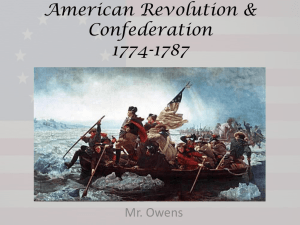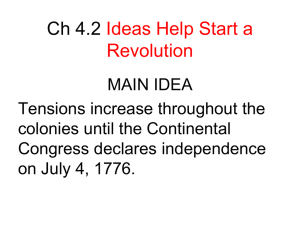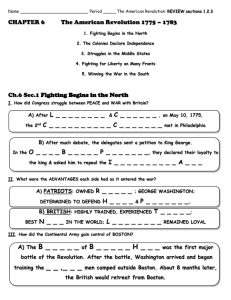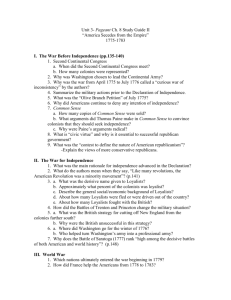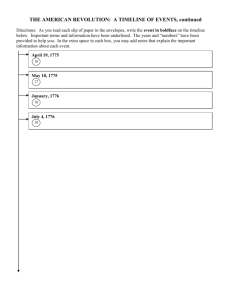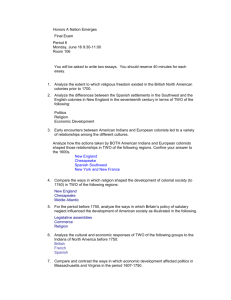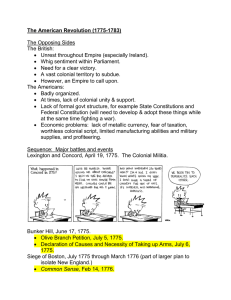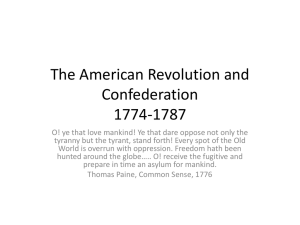American Revolution & Confederation 1774-1787
advertisement
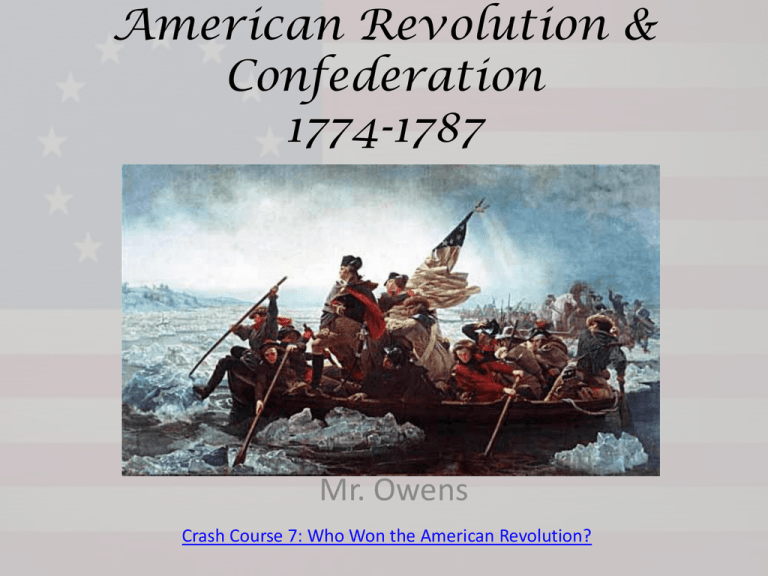
American Revolution & Confederation 1774-1787 Mr. Owens Crash Course 7: Who Won the American Revolution? Essential Questions: • What were the key ideas expressed in Thomas Paine’s Common Sense and the Declaration of Independence and what impact did they have on American history? • What caused colonized to join the Patriot cause and how were the able to mobilize support for the movement? • What advantages and disadvantages did the Patriots and Great Britain have in the War for Independence, and what were the causes of Patriot victory? First Continental Congress- 1774 • 55 delegates from 12 colonies (no GA) meet in Philadelphia – 1 vote each discuss response to “Intolerable Acts” in Sep. 1774 • Radicals: Patrick Henry, John & Samuel Adams • Moderates: George Washington & John Dickinson (PA) • Conservatives: John Jay (NY) & Joseph Galloway (PA) • Loyalists not represented • ACTIONS: 1. Suffolk Resolves – repeal Intolerable Acts, boycott, military preparations (radicals) 2. Declaration of Rights & Grievances – (moderates)petition to King George III to redress colonial grievances & restore rights 3. The Association – network of committees to enforce economic sanctions in #1 4. If rights not restored, meet again in May 1775 Fighting Begins • King George III – ignored colonial petitions, declared MA in a state of rebellion – sent more troops • Lexington & Concord: April 18, 1775 British marched to capture weapons in Concord • Warned by William Dawes & Paul Revere • Minutemen (militia) faced British at Lexington Green, 8 Minutemen killed • Turned back in Concord, British 250 casualties on march to Boston mostly from ambush or snipers • Bunker Hill – June 1775 British take Breed’s Hill but suffered over 1,000 casualties against militia of MA farmers. Moral victory for Americans? Second Continental Congress • Philadelphia from May 1775 to July 1776 • Divided – New England calling for independence, Middle Colonies negotiation 1. “Declaration of Causes and Necessities of Taking Up Arms” – colonies provide troops, Washington commander-in-chief – Raiding force into Quebec hope for Canada to join the cause – Created American navy & Marine corps to attack British shipping 2. “Olive Branch Petition” July 1775 – many colonies rejected independence, pledged loyalty to King George III – wanted peace & colonial rights – 3. 4. King issued Prohibitory Act = declared colonies in rebellion Opened ports to foreign nations – Model Treaty (John Adams) “The Association” June 7, 1776 Richard Henry Lee (VA) introduced resolution called for independence. Common Sense & Declaring Independence • Thomas Paine’s Common Sense (Jan 1776) radical pamphlet for independence & rejection of monarchy • Declaration of Independence – drafted by Thomas Jefferson w/ help from John Adams & Ben Franklin • July 2nd, 1776 Congress adopted Lee’s resolution for Independence. Independence Day? • July 4th, 1776 Declaration of Independence was formally adopted Patriots & Loyalists • 2.6 million lived in colonies @ 40% were Patriots, 2030% Loyalists, remaining 30-40% were neutral • Much of the war closer to a Civil War • Patriots: largest numbers from New England & Virginia. – Most served in local militias for short periods. – Washington never had more than 20,000 troops at one time. Poorly equipped, supplied, & rarely paid. – 5,000 African Americans served, mostly free blacks from North • Loyalists (Tories): 60,000 fought with British. – Tended to be wealthy & more conservative – Majority in NY, NJ & GA. – Anglican clergy & many government official including William Franklin (BF’s son) – American Indians sided with British who promised to limit western settlement On the Eve of the Revolution ? Britain Americans Advantages ? ? Disadvantages ? ? The Revolutionary War • 1775-1777 series of losses including British occupation of New York and Philadelphia • Demoralized winter of 1777-1778 in Valley Forge, PA • 95% decline in trade: goods scarce, inflation, “continentals” become worthless • Turning Point: Battle of Saratoga in NY Oct. 1777 – Leads to French Alliance w/ Louis XVI in 1778 (secretly given aid earlier) & loans from Holland - Spain & Holland join alliance in 1779 • Patriot Victory: – Ohio Valley campaign George Rogers Clark captured British forts 17781779, 1780 failed Southern Campaign British relied to heavily on Loyalists support & tried to recruit slaves – Yorktown: 1781 Lord Cornwallis army surrenders after being surrounded by Washington’s & French army & navy – War became unpopular in England, Lord North & Tories resigned, Whigs gained control of Parliament pushed for peace • Treaty of Paris of 1783: (Jay, Adams, Franklin) 1. Britain formally recognized US independence 2. Land east of Mississippi River 3. America to have fishing rights off Canada coast 4. Americans would pay debts to British merchants & return Loyalist property Essential Questions: • What were the key elements of the Articles of Confederation and why and to what extent was the federal government limited? After the Revolution, what led to calls for strengthening the federal government? • What impact did the American Revolution have on women? What was the concept of “republican motherhood” and why was this significance? New Governments • 13 colonies became states with new state constitutions • Debates between conservatives: law & order, & liberals: individual rights & protection from tyranny • Each had in common: – “Bill” or “Declaration” of Rights and freedoms – Separation of Powers: to protect against tyranny 1. elected Bicameral legislature 2. elected governor 3. court system – Voting rights: all property-owning white males – Office-Holding qualification usually higher than voting • Articles of Confederation: drafted by John Dickinson, adopted in 1777 by Congress – officially ratified by states in 1781 after VA & NY dropped claim to Ohio Valley – Central Government w/only 1 body: a unicameral Congress, no executive or federal court system – Each state 1 vote (equal representation) 2/3 needed to pass laws, & all 13 states needed to pass Amendments – Powers: wage war, treaties, diplomacy, borrow money – No Power to regulate commerce or collect taxes Articles of Confederation (1781-1787) • Accomplishments: 1. Winning the war, negotiating alliances & favorable peace 2. Land Ordinance of 1785: policy of surveying western lands: “the grid” promoted public education 3. Northwest Ordinance of 1787: (Ohio Valley & Great Lakes area) set rules for creating new states, allowed limited territorial self-gov. & banned slavery • Problems: 1. Financial: war debts & pensions unpaid, states & Congress issued worthless paper $, no tax power= had to request $ from states. Couldn’t promote trade. 2. Foreign: European lack of respect, 13 potential trade policies, couldn’t pay debts: Britain & Spain threatened to expand in West. 3. Domestic: Shays’ Rebellion 1786-1787 Daniel Shays’ led revolt of MA farmers against high state taxes, debtors prison, and lack of paper $. Private army raised to defeat it. Indian threat in the West. • • • • • • Social Change Abolition of aristocratic titles, no primogeniture laws, but no major redistribution of wealth Separation of chrch & state: Anglican church de-established, only New England (NH, CT, & MA) had tax-supported Congregational Church (until 1830s), Quakers also lost influence, Catholic church status improved. Women: during war many worked as cooks & nurses, a few fought in battle Mary McCauley (Molly Pitcher) & Deborah Sampson, maintained colonial economy, but after war still 2nd class status despite Abigail Adams plea to “Remember the ladies and be more generous and favorable to them than your ancestors.” – Did they? New emphasis: “Republican Motherhood” – women’s role important to educate and serve as model for future (male) citizens Slavery: some inspired by “all men are created equal”, Congress banned international slave trade, gradual emancipation laws in North, but overall expanded Indians: blamed for British alliance, pushed further West “Civilization or death to all American Savages” 4th of July toast
